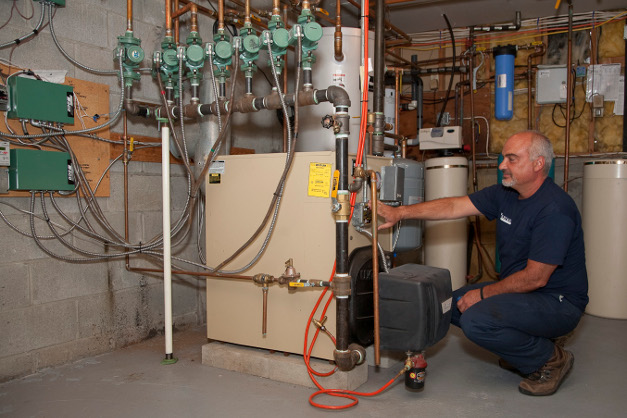
May 2020
When we think about the old adages of the oil heat industry, there are few that uttered more frequently than “service is just part of the cost of doing business.” If I’ve heard it a hundred times, that would be an understatement. Dealers have said it, conference presenters have included in in their PowerPoint slides and, to some degree, even homeowners understand the statement to be true. But, what the sentiment carries behind its simple phraseology, is a number of perspectives that nobody ever seems to put much thought into. An unplanned service call is part of doing business, but the ripple effect each of these calls comes with is largely overlooked.
The first, and most obvious place to start, is with the company perspective. Unplanned service calls interrupt whatever else the employees are supposed to be doing. Office staff is rarely ever waiting to only answer phones. Instead, they are typically in rhythm lockstep, answering phones, processing checks, and working through the company database—what those folks will sometimes refer to as “my real work.”
Second, these repeated emergency calls can take an emotional toll on the dealer. It’s not only understandable, but also too often that a dealer may ask themselves if the calls will ever stop. They may question where the issue is coming from in the first place. Is it my supplier? Finally, there’s the financial concern. As the calls are unscheduled, they are inherently costly. You’re sometimes doing these calls on overtime or using subcontractors for additional support. Regardless, unscheduled equals costly.
Customer is on an agreement contract? Scratch that call up to another no-charge event. No-contract customer? Okay, but how long until you drive a customer away because you’ve been to the house three times in 45 days? Finally, the future is nothing if not uncertain. The emergence of Covid-19 has created yet another hurdle: the safety and wellbeing of not only your employees, but the customer as well.
From the customer perspective, the second head of the monster emerges. Let me be frank. You are never going to get there fast enough, even within a two to three hour window, a reality that may actually be unique to the oil heat industry. Couple that with the anxiety of no-heat, the worry about unseen costs, and the fact that the customer most certainly had something better to do that particular day, and you undoubtedly have an unhappy homeowner.
“I hope this doesn’t cost a lot. I already buy their oil.”
What is the cause of these unplanned service calls? That’s the $64,000 question. The answer is typically found in the back-office software, coded as something along the lines of “nozzle, filter, strainer replacement.” So, perhaps the better question might be why the customer is having issues with a nozzle, filter, or strainer? As the customer may have told you, “you were here only six months ago.”
The real answer is sludge..it’s sedimentation…it’s the black mass inside the bottom of a tank. Water, “algae” and dirty fuel has carved out a home down there, and when a delivery is made, that concoction gets stirred up quickly. Once the burner calls, the sludge makes its way down to the filter and, well, you know what happens next. What the problem was 30 years ago is the same thing today, what we call the pitch, vent, and suction line dilemma. These are three things that are common with all of the legacy equipment out there. Every tank is vented to the atmosphere and, as a result, every tank is susceptible to condensation from time and temperature changes. The Steel Tank Institute has identified that water is the number one contaminant in fuel. That moisture provides a safe haven for microbes to live and reproduce, eating the hydrocarbons in fuel, and driving the production of acetic acid, which is corrosive to tank walls and lines.
This problem isn’t new. I’ve certainly sung this tune a long while. But I can tell you that the Steel Tank Institute also recommends proper tank installation and treatment of fuel. And let’s not forget NORA. They’ve chimed in and let us all know that pump sticking—not leaking—but sticky, varnish residue in fuel pumps is another sad reality caused by sludge and bacterial build up.
Defeating this multi-headed monster starts with understanding your role as a fuel provider, and what cannot come more highly recommended: Housekeeping and fuel testing. A good and cheap place to start is sticking bulk storage tanks with water-finding paste. If there’s water in your bulk tank, there’s a good chance it has made its way downstream to you customers. Keeping tank bottoms dry will eliminate most of your exposure because your tanks have vents on them, too. They are not immune to time and temperature.
Action items to mitigate these issues and resulting service calls begin with diagnosis—sticking the tank or testing the fuel. Beyond that, you should consider working with a fuel-quality company to introduce a multi-functional treatment program that begins and ends with stabilization of the fuel, protecting it from time and temperature. Chemistry is your friend, works overtime with no additional pay, and fights against corrosion, fuel degradation, etc. It’s no wonder that pipeline companies use corrosion inhibitors in their fuels. They understand the breakdown of fuel and the risk associated with it.
Biodiesel blends? Not a problem. Any fuel-quality company worth their weight is going to provide you a package with biodiesel stabilizer. These low carbon liquid fuels are the pathway to our future as an industry, and we understand that. Which is why we introduced dual biodiesel stabilizers in our heating oil treatment packages close to a decade ago.in 2012 and modified it again in 2017 anticipating higher blends of biodiesel would become the norm.
Maybe you’ve thought about treatment. Perhaps you’ve been wondering what the cost is associated with it? I’ll say this: any cost associated with introducing an additive solution is quickly offset by the financial benefit to the company—typically in multiples. Alternatively, what does it cost you to send a technician to a home to address one of those unplanned service calls? You could be doing other work, scheduling installs, etc. Secondly, your reputation may suffer as a result of an unhappy customer. Lastly, the economics of sending out a technician is costly.
We’ve read that the average cost of an employee in a van is somewhere between $90-$120 an hour. As an example, let’s assume an unplanned service call costs $165. Now, if we, as your additive provider, can reduce one service call for every 20 customers, you may be spending $80 a year to treat the fuel across your company, but I’m giving you back $165. And, more often, we are eliminating not one, but dozens of unplanned service calls a year. The ROI is immediate.
Treatment isn’t a challenge. Whether you are a dealer with 20 trucks or a one man show, treatment options can be loaded into bulk storage as easily as a single delivery truck. Make sure your additive provider is willing and able to meet your specific business needs. One size does not fit all.
If you decide to treat your fuel, wonderful. And if you do that, take credit for it. That’s how you differentiate yourself from your competition in the marketplace. Branding is a great way to let your customer know you are taking care of them from the inside out.
You’ve built a good name for yourself as a trusted and essential member of the community. Don’t let the monster of unplanned service calls dent your reputation and brand. Taking responsibility for the integrity of the fuel you provide begins today. There is no better time than now.
Barry Aruda is the Northeast Regional Territory Manager for Advanced Fuel Solutions. As an admitted “fuel quality fanatic,” he spends a great deal of his full-time job testing fuel for analysis, recommending preventative defensive strategies, and working with dealers to overcome the challenges of housekeeping and changing technology.

